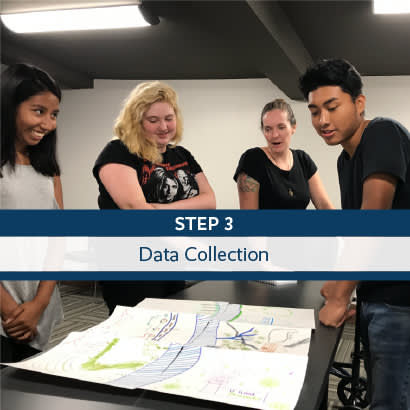Conduct data collection and analysis, including both qualitative and quantitative. For quantitative data, use geographic information systems (GIS) to understand quantity, proximity, connections and amenities of park space currently available and where gaps and inequities in distribution may exist. For qualitative data, use community engagement, audits and resource analysis to understand park quality, cultural relevancy, safety and inclusion.
Conducting a Community Needs Assessment
It is crucial for your agency to use several data sources to inform your planning process. A community needs assessment is a wide-ranging survey that will give you the information you need from community members regarding your park system, recreation centers and other services — specifically, how well they feel their health & wellness needs are being met, and details on their historical and current barriers to access and their priorities that your agency may not be currently addressing. It is particularly important in a system-wide needs assessment that you collect enough data to accurately represent each neighborhood and demographic group in your community.
If your agency has never collected this kind of feedback, the NRPA Community Needs Assessment resource will guide you step-by-step to get clarity on the data you need, to design a high-quality assessment, to achieve a high response rate, and to take action on the data to inform your master plan.
Geographic Information Systems (GIS)
A GIS database allows you to map and run analysis on the many aspects of your park system. Important park metrics include distribution of park acreage, park access in a 10-minute walk, sidewalk and walking access to parks. Additionally, you can layer these park metrics with demographic, environmental, community investment and other data to create mechanisms for analyzing and prioritizing park projects based on outcomes related to parks. If you don’t have a GIS database, using online resources, such as ParkServe, can help fill this gap.
System-Wide Metrics
There are several benchmarks and metrics that are currently being used to measure distribution and quality of parks at a system level. These metrics help to identify areas with gaps in close-to-home park access, lack of quality amenities or amenities that don’t match community priorities, and distribution of park maintenance and capital spending. It is important to not only gather data on the number of parks and acres, but also the quality of parks and the amenities they offer.
The following metrics should be included in every master plan at both a system and neighborhood level, as they measure access, quality and distribution of park resources. For an equity-based plan, it is essential to measure the distribution metrics based on population demographics and outcome indicators, such as health and safety.
| System-Wide Metric – measures that provide a high-level overview of the system as compared to national, state and/or regional averages |
Distribution Metric – measures that provide a nuanced indicator of distribution of parks, spending and quality based on neighborhood, park and/or population demographics |
Population Demographics & Outcome Indicators – measures that indicate population-level outcomes or risk of poor outcomes to help guide decisions about distribution of resources |
| Park Acres per 1,000 Residents |
Park Acres per 1,000 Residents |
Rates of chronic disease – asthma, diabetes, heart disease |
| Park Access – percent of people living in a 10-minute walk (half-mile) of a park |
Distribution of Amenity Types as compared to desired amenities |
Climate risks – flooding and heat islands, tree canopy |
| Variety of Park Amenities |
Distribution of Asset Ratings |
Socioeconomic data – race & ethnicity, income, age, gender |
| Quality and Condition of Park Amenities |
Average Number of Users per Park |
Access Indicators – density, car ownership, age, public transportation |
| Overall Park Use |
Operating Expenditures Used per Park in Maintenance and Programming |
Safety – traffic fatalities and incidence, violent and nonviolent crime |
| Operating Expenditure per Capita |
|
|
Benchmarking
Park and recreation agencies are as diverse as the communities they serve, and what works well for one agency may not be best for your agency. While every community is different, national benchmark data can help to identify the best practices to optimally serve your community and provide context for your community’s park metrics. Below are a few resources to help with benchmarking:
- NRPA’s Park Metrics is an online database where you can enter your agency’s numbers and see how you compare to your peers. The NRPA Agency Performance Review report is a companion to the database that provides a comprehensive overview of the data and insights from Park Metrics and includes 23 figures highlighting critical park and recreation metrics.
- The Trust for Public Land’s ParkServe is a free mapping platform that helps you pinpoint where to focus park investments in your city. They’ve mapped park access in 14,000 cities and towns across the country.
- Statewide Comprehensive Outdoor Recreation Plans (SCORP) are created at a state level as a requirement of the Land and Water Conservation Fund (LWCF). Aligning your plan with your state SCORP will increase your review score when applying for federal LWCF funds.
Connecting to City Priorities and Park Benefits
It is important to gather data that will compel elected officials and other city leaders to buy in to the project. Gather data that will make the case that parks are a vital piece of infrastructure, provide multiple benefits to a community and align with your city and elected official’s top priorities.
 Case Study: In order to propose recommendations for the plan, Grand Rapids, Michigan, conducted vigorous assessments on city inventory, demographics, access and level of service. See Chapter 2 "Grand Rapids Park and Recreation System Today" to learn which benchmarking comparisons influence decisions.
Case Study: In order to propose recommendations for the plan, Grand Rapids, Michigan, conducted vigorous assessments on city inventory, demographics, access and level of service. See Chapter 2 "Grand Rapids Park and Recreation System Today" to learn which benchmarking comparisons influence decisions.


